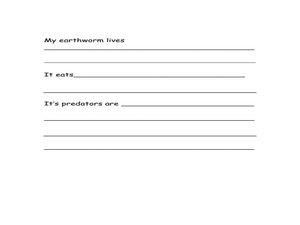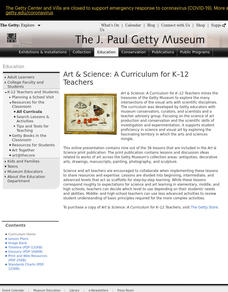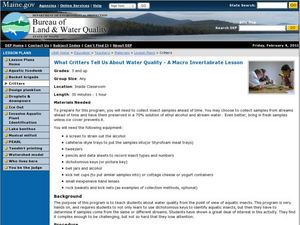Michigan State University
May I Take Your Order?
If you're a pest, come and get a tasty meal here! Scholars work collaboratively to construct a mini restaurant out of a shoe box and create a menu that feeds a pest their favorite food.
Curated OER
Earthworms and Making a Wormery
Students explore the environment by researching insects. In this earthworm lesson, students utilize soil and plexiglass to build a see through wormery in which students can observe the worms at work. Students identify the benefits of...
Curated OER
Life Cycles
Using computers, Students work in small groups and progress through the roles of Explorer, Researcher, Designer, and Evaluator as they study the life cycle of plants, insects, butterflies and frogs.
Curated OER
Giant Smelly Plant Attracts Thousands
Read and discuss a news article about a rare corpse plant that bloomed in Washington D.C. Because this native Indonesian plant blooms so rarely, people flock to see it. After reading the article, your class answers comprehension...
Curated OER
Layers of the Rainforest
What a great way to discuss the rainforest! Learners discuss the importance of adaptation in the environment and how it is linked to survival. They use critical thinking and inference skills to place animals and insects in the different...
Curated OER
Spider Safari
Today we are talking about one of the stealthiest, sneakiest, and most intriguing insects of all times, the spider. Learners will examine the predatory nature of these super bugs as they conduct a spider safari survey. Each child will...
PBS
Reading Adventure Pack: Building
Scholars become architects in an engaging unit on building structures. The Reading Adventure Pack features Roberto: The Insect Architect by Nina Laden and Construction Zone with photographs by Richard Sobol and text by Cheryl Willis...
University of Kentucky
The Great Spider Debate
Poor, misunderstood spiders! They are feared, disrespected, and detested by many people, yet they do so many positive things. A great addition to any insect unit, learn about some of the more common spiders, while hopefully dispelling...
Michigan State University
Bug Lyphe!
Introduce ecology classes to biodiversity and interdependence in ecosystems with a PowerPoint presentation. Then, they get up-close and personal with the invertebrate world by collecting insects, classifying them, and graphing their...
Gwinnett County Public Schools
Analysis of the Tuck Everlasting and The Birchbark House Text Exemplars
Looking to introduce some text-based questions into your ELA lessons? Practice the kinds of skills the Common Core demands with the seven text-based questions and the essay prompt provided here. Designed to be a three-day lesson, day one...
Kenan Fellows
Use of Dichotomous Keys to Identify Stream Organisms
What kind of organisms are living in the stream? After an explanation on how to use a dichotomous key, groups of three to four use the keys to identify macroinvertebrates from a local freshwater stream. Using the the concept of Stream...
Curated OER
Minimal Animals
Have fun creating imaginary creatures with this symmetry lesson plan! Your class will paint one half of their imaginary creature, fold their paper in half, which will result in a symmetrical figure. What a great art project to combine...
Curated OER
Photosynthesis
Fifth graders work in small groups to brainstorm responses to a problem related to some disaster that wipes out half or all plant life on earth. Groups complete a graphic organizer to compare and contrast their ideas. Students select...
Prince William Network
The Incredible Journey
Divide your school gym into breeding grounds and non-breeding grounds so that your zoologists can play a game simulating the seasonal migration of shorebirds. Players pick one of the included game cards and follow its directions, which...
National Park Service
The Secret of Life
Dead trees provide nutrients for the soil, food for animals, protection and a home for organisms, a seed-bed for new trees, and a place for nitrogen-fixing bacteria to live. In the activity, pupils collect decaying logs, expose them to a...
Curated OER
Cryptogram: Grade Four Vocabulary List One
In this cryptogram activity, students unscramble ten words by placing the correct letter in the shaded boxes. Students then use the numbered boxes to decode a cryptogram. There is no word list on the page.
Curated OER
Bugs in the Woods
Second graders identify insects and plants in the forest ecosystem in a structured field trip with stations and activity booklets. In this bugs instructional activity, 2nd graders explore the ecosystem of the forest, complete the...
Curated OER
Mouthpart Madness
Learners explore the basic biology of a pest. They identify the four major kinds of insect mouthparts and explain how they work. Students examine the specific mouthparts and how they can limit food resources and in what environment an...
Curated OER
Buggy Diner
Students observe different insects and the different kinds of foods they like to eat. In this insects lesson plan, the teacher collects insects and different plants and roots. Then the students learn about those insects and have to be...
Curated OER
Creepy Crawlies
Students participate in several insect-themed activities. They read stories on bugs, write stories about insects with student-made illustrations, sing bug-themed songs, design creepy crawlies with typical insect characteristics and make...
Curated OER
Clearly Classified
Learners investigate plants and insects. In this science classification lesson plan, young scholars create separate categories for insects and plants by characteristics. Learners discover scientific names of insects.
Curated OER
Investigating Crickets and Their Body Parts
Second graders investigate the body of a cricket. In this biology lesson students use tools to gain information about the insect the cricket. Students observe and identify features and describe how these features help the cricket live in...
Curated OER
Macroinvertebrate Mix and Match
Students are introduced to macroinvertebrates (primarily insects), the major segments of aquatic insects (the head, thorax and abdomen) and also differentiate between larval, nymph and adult stages. They investigate the head, thorax and...
Curated OER
What Critters Tell Us About Water Quality: A Macroinvertebrate Lesson
Students explore our ecosystem by investigating the quality of our water. In this aquatic insect lesson, students examine a group of random insects collected from different streams and ponds in the area. Students record their...

























